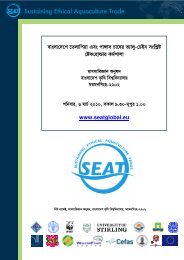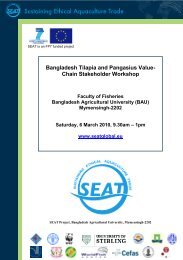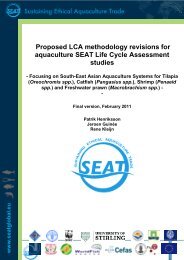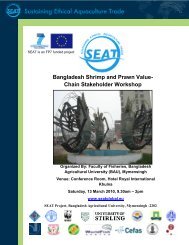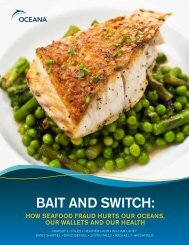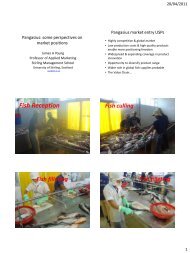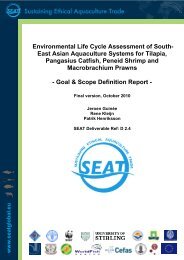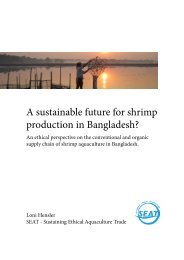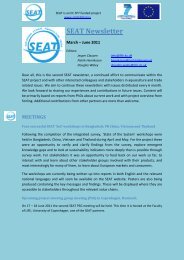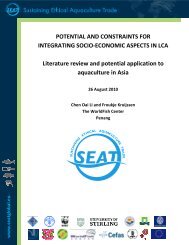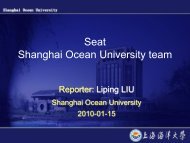D4.1 Review of Environmental Models - SEAT Global
D4.1 Review of Environmental Models - SEAT Global
D4.1 Review of Environmental Models - SEAT Global
You also want an ePaper? Increase the reach of your titles
YUMPU automatically turns print PDFs into web optimized ePapers that Google loves.
spreadsheet and used mass balance techniques to quantify waste material (uneaten<br />
feed/faeces), the second sub-model was also run in a spreadsheet and used Gowen’s<br />
formula (Gowen et al, 1989) to calculate the distribution <strong>of</strong> waste and finally the third submodel<br />
was carried out using GIS s<strong>of</strong>tware involved the calculation and generation <strong>of</strong> the<br />
final contour distribution diagrams (Pérez et al 2002). As noted by Brooker (2002) the main<br />
limitation <strong>of</strong> the model developed by Pérez et al (2002) is that for a user experienced in GIS,<br />
spreadsheets and image manipulation it takes some time to become familiar with the model<br />
in order to operate it successfully and without previous experience it would be very difficult<br />
to operate the model. Furthermore, the model is limited in its use as it is unable to model<br />
large cage sites or handle large hydrographic datasets due to the size limitations <strong>of</strong> the<br />
spreadsheet models (Brooker, 2002).<br />
Although the model developed by Pérez et al (2002) had made some advances in integrating<br />
a waste dispersion model (via loose coupling) into a GIS there were some limitations, mainly<br />
due to the complex interaction between the spreadsheet sub-models and the GIS model.<br />
Brooker (2002) and Corner et al (2006) further expanded on the work by Pérez et al (2002)<br />
by fully integrating a particulate waste distribution model into GIS s<strong>of</strong>tware using a<br />
specifically developed program module and thus removing the use <strong>of</strong> separate spreadsheet<br />
models. A typical output from the model (Figure 2.6) shows a double row <strong>of</strong> individual fish<br />
cages and the quantified spread <strong>of</strong> waste material around them. The module was produced<br />
using the development tool DELPHI 3 (Borland S<strong>of</strong>tware, California, USA) and was then fully<br />
integrated into IDRISI32 (Clark Labs, Massachusetts, USA) using the IDRISI Application<br />
Programming Interface (API) (Brooker, 2002; Corner et al, 2006). These studies were<br />
analysing the impact <strong>of</strong> aquaculture systems on the local environment and are useful to<br />
predict potential impacts in the future which is advantageous to regulators when it comes to<br />
licensing new aquaculture systems and granting consent to discharge wastes (Pérez et al,<br />
2002). The use <strong>of</strong> GIS and waste dispersion models together is an extremely useful<br />
environmental management tool and could be applied in integrated coastal zone<br />
management (ICZM).<br />
In addition to being a useful management tool for regulators, the models are useful for the<br />
farmers themselves providing they are in a simple, user-friendly format. Tironi, Marin &<br />
Campuzano (2010) developed a management tool that could be used to assess the<br />
particulate waste dispersal <strong>of</strong> salmon farming activities by combining a hydrodynamic<br />
model, a particle tracking module and a GIS application. The hydrodynamic model was<br />
developed using the free opensource MOHID Water Modeling System v.4.6 (Braunschweig<br />
et al 2004; Neves, 1985), which was also used to simulate the dispersion <strong>of</strong> the particulate<br />
wastes using the Lagrangian module. The results <strong>of</strong> the hydrodynamic model and the<br />
particle tracking module were then combined within a GIS environment to create a<br />
management tool using a modified ArcView 3.3 (ESRI) interface which was programmed<br />
using AVENUE which is the scripting language for ArcView 3.3. Unlike the model developed<br />
by Corner et al (2006) the model produced by Tironi, Marin & Campuzano (2010) has not yet<br />
been fully validated due to a lack <strong>of</strong> available data, however as the management tool is<br />
already used by local decision makers and the hydrodynamic model is able to simulate<br />
dynamics within the Patagonian fjordic environment the authors note that it can be<br />
considered partially validated. As the tool was being developed for salmon farmers in Chile<br />
the text on buttons and in the help/information was translated into Spanish which is the<br />
local language and throughout the development the developers checked the local manager’s<br />
capabilities, needs and requirements to ensure efficient usability <strong>of</strong> the tool (Tironi, Marin &<br />
Campuzano, 2010). By incorporating the target user(s) during the development process it<br />
ensures that the tool can be understood and operated more efficiently and effectively by the<br />
user(s) and that if they have any requirements then it is easier to adjust/ add/modify the<br />
Page 35



